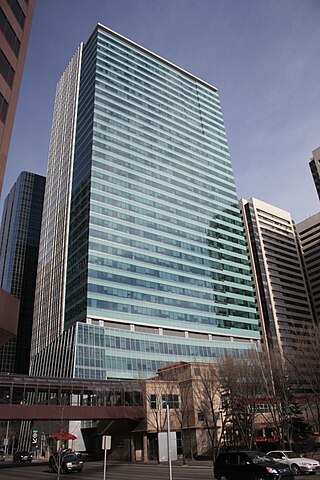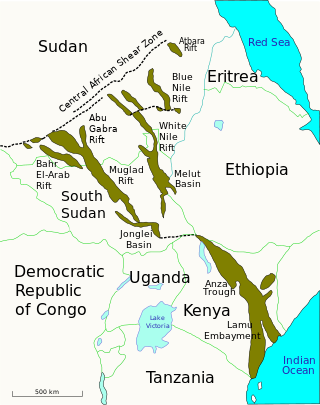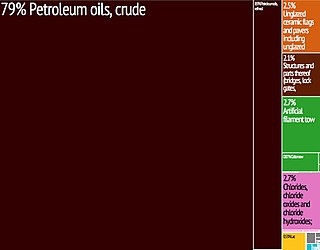
The economy of Sudan has boomed on the back of increases in oil production, high oil prices, and large inflows of foreign direct investment until the second half of 2002. GDP growth registered more than 10% per year in 2006 and 2007. From 1997 to date, Sudan has $30.873 billion by gross domestic product as of 2019, and has been working with the International Monetary Fund (IMF) to implement macroeconomic reforms, including a managed float of the exchange rate. Sudan began exporting crude oil in the last quarter of 1999.
The Rumaila oil field is a super-giant oil field located in southern Iraq, approximately 50km to the south west of Basra City. Discovered in 1953 by the Basrah Petroleum Company (BPC), an associate company of the Iraq Petroleum Company (IPC), the field is estimated to contain 17 billion barrels, which accounts for 12% of Iraq's oil reserves estimated at 143.1 billion barrels. Rumaila is said to be the largest oilfield ever discovered in Iraq and is one of the third largest oil fields in the world.

PetroChina Company Limited is a Chinese oil and gas company and is the listed arm of state-owned China National Petroleum Corporation (CNPC), headquartered in Dongcheng District, Beijing. The company is currently Asia's largest oil and gas producer. Traded in Hong Kong and New York, the mainland enterprise announced its plans to issue stock in Shanghai in November 2007, and subsequently entered the constituent of SSE 50 Index. In the 2020 Forbes Global 2000, PetroChina was ranked as the 32nd-largest public company in the world.

China Petroleum & Chemical Corporation (中国石油化工股份有限公司), or Sinopec, is a Chinese oil and gas enterprise based in Beijing. It is listed in Hong Kong and also trades in Shanghai.

TC Energy Corporation is a major North American energy company, based in the TC Energy Tower building in Calgary, Alberta, Canada, that develops and operates energy infrastructure in Canada, the United States, and Mexico. The company operates three core businesses: Natural Gas Pipelines, Liquids Pipelines and Energy.

The China National Petroleum Corporation (CNPC) is a major national oil and gas corporation of China and one of the largest integrated energy groups in the world. Its headquarters are in Dongcheng District, Beijing. CNPC was ranked fourth in 2022 Fortune Global 500, a global ranking of the largest corporations by revenue.
Oil India Limited (OIL) is a central public sector undertaking engaged in the business of exploration, development and production of crude oil and natural gas, transportation of crude oil and production of liquid petroleum gas. The central public sector undertaking is a Maharatna, with the Ministry of Petroleum and Natural Gas overseeing its operations. Headquartered in Duliajan, Assam, the company has its offices in Duliajan, Noida, Guwahati and Jodhpur.

Petroleum production in Canada is a major industry which is important to the overall economy of North America. Canada has the third largest oil reserves in the world and is the world's fourth largest oil producer and fourth largest oil exporter. In 2019 it produced an average of 750,000 cubic metres per day (4.7 Mbbl/d) of crude oil and equivalent. Of that amount, 64% was upgraded from unconventional oil sands, and the remainder light crude oil, heavy crude oil and natural-gas condensate. Most of the Canadian petroleum production is exported, approximately 600,000 cubic metres per day (3.8 Mbbl/d) in 2019, with 98% of the exports going to the United States. Canada is by far the largest single source of oil imports to the United States, providing 43% of US crude oil imports in 2015.

The Caspian Pipeline Consortium (CPC) is a consortium and an oil pipeline to transport Caspian oil from Tengiz field to the Novorossiysk-2 Marine Terminal, an export terminal at the Russian Black Sea port of Novorossiysk. It is one of the world's largest pipelines and a major export route for oil from the Kashagan and Karachaganak fields. The CPC pipeline transfers about 1% of global oil supply and handles almost all of Kazakhstan's oil exports. In 2021, the pipeline exported up to 1.3 million barrels per day (bpd) of Kazakhstan's main crude grade, light sour CPC Blend, which represented 80% of Kazakhstan's total oil production of 1.6 million bpd.

Energy consumption across Russia in 2020 was 7,863 TWh. Russia is a leading global exporter of oil and natural gas and is the fourth highest greenhouse emitter in the world. As of September 2019, Russia adopted the Paris Agreement In 2020, CO2 emissions per capita were 11.2 tCO2.

The Muglad Basin is a large rift basin in Northern Africa. The basin is situated within southern Sudan and South Sudan, and it covers an area of approximately 120,000 square kilometres (46,000 sq mi) across the two nations. It contains a number of hydrocarbon accumulations of various sizes, the largest of which are the Heglig and Unity oil fields. During the 1960s and 1970s, Chevron made the first oil discoveries in the basin near the towns of Bentiu, Malakal, and Muglad. Taken together, the Muglad and Melut rift basins account for the majority of Sudan's known oil reserves.

The Melut Basin is a rift basin in South Sudan, extending into Ethiopia, where it is called the Gambella basin. Melut is situated in the Upper Nile and Jonglei, south of the capital of Sudan, Khartoum and east of the river Nile. Some parts of the Melut contain several known hydrocarbon accumulations, although oil exploration, as elsewhere in Sudan and South Sudan, has been hindered by instability and conflict. The largest oil field in the Basin is the Great Palogue Field in South Sudan, with estimated reserves of 900 million barrels. The Melut oil export pipeline travels 1,380 km from Palogue to Port Sudan on the Red Sea, and has been on stream since June 2006.

The petroleum industry in Western Australia is the largest contributor to the country's petroleum exports. Western Australia's North West Shelf (NWS) is the primary location from which production originates. Oil exports are shipped from Port Hedland.
Perenco is an independent Anglo-French oil and gas company with a headquarters in London and Paris. It conducts exploration and production activities in 16 countries around the globe.

The Adar oilfield, also known as the Adar Yale, Adar Yeil or Adaril field, is an oilfield situated in the Melut in South Sudan estimated to contain about 276 million barrels (43,900,000 m3) of oil. The Chevron Corporation discovered the Adar Yale field in 1981, shortly before the start of the Second Sudanese Civil War (1983–2005). Soon after Chevron had suspended operations in 1984, Sudanese government troops began attacking civilian settlements in the area, burning the houses and driving the people away, and in the late 1990s, Nuer militias from Nasir helped the army in clearing away the people to make way for the roads and infrastructure of the oilfield.
Energy in Sudan describes energy and electricity production, consumption and imports in Sudan. The chief sources of energy in 2010 were wood and charcoal, hydroelectric power, and oil. Sudan is a net energy exporter. Primary energy use in Sudan was 179 TWh and 4 TWh per million persons in 2008.
The Uganda–Kenya Crude Oil Pipeline (UKCOP) was a proposed pipeline to transport crude oil from Uganda's oil fields in the Northern and Western Regions to the Kenyan port of Lamu on the Indian Ocean. Along the way, the pipeline would have picked up more crude oil from the South Lokichar Basin and other oil fields in northwestern Kenya and delivered it to Lamu for export. South Sudan had also planned to construct a pipeline from its Unity State, linking to the UKCOP as an alternative to its only current oil export route through Port Sudan in its northern neighbor Sudan.

Chad maintains sizable reserves of crude oil which, alongside agriculture, makes up the largest share of the landlocked former French colony's export revenue. Producing around 100,000 barrels of oil a day, most of Chad's crude comes from its reserves in the Doba Basin in southern Chad where oil was discovered in the early 1970s by foreign drillers. There is an estimated one billion barrels of oil in Chad, most of it being exploited by hundreds of rigs operated by Western companies such as Exxon-Mobil and Royal Dutch Shell. However, many challenges exist to Chad's petroleum industry including but not limited to corruption, internal conflict, and geography. Since Chad is landlocked, most of Chad's oil exports are transported out of the country by a pipeline that leads to the Cameroonian port city of Kribi. This pipeline, owned by a consortium, has come under fire due to allegations of exploitation by international corruption watchdogs, and Chadian politicians. In addition, environmentalists have voiced their concerns over the pipeline's impact on the natural environment, citing several spills.
The petroleum industry in Sudan began in 1979, when the first commercial flow in the country occurred.
The Niger–Benin Oil Pipeline, also known as Niger-Benin Export Pipeline (NBEP), is a 1,950 kilometer long crude oil pipeline connecting oilfields near the desert oasis of Agadem in Niger to the Atlantic Ocean. It ends in the Gulf of Guinea near Benin's largest city Cotonou. The pipeline was built between 2019–23, with exports expected to begin in January 2024. The pipeline will be operated by the China National Petroleum Corporation (CNPC).










